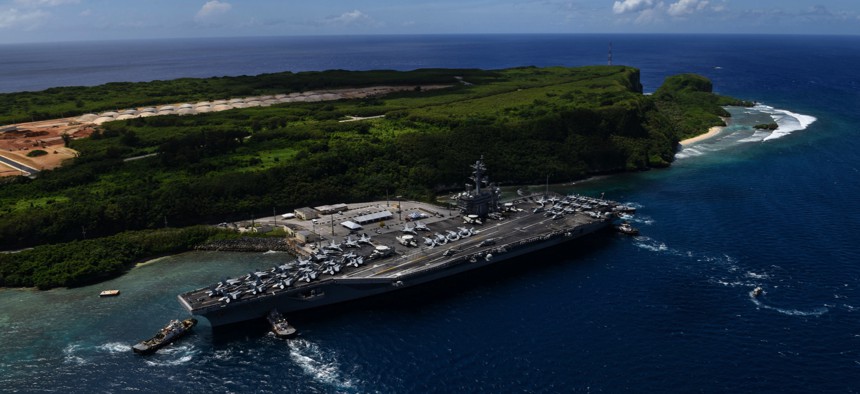
This 2017 photo shows the USS Theodore Roosevelt leaving the pier at Naval Base Guam. U.S. Navy / Mass Communication Specialist 3rd Class Anthony J. Rivera
US Sailors Pour Off Aircraft Carrier and Into Coronavirus Isolation on Guam
Navy leaders praise ship’s captain for urgent evacuation request; 3,700 will leave the ship within days.
About one-fifth of the USS Theodore Roosevelt’s 4,865 sailors are off the COVID-stricken aircraft carrier and into isolation on Guam, with about 2,700 more expected to evacuate in the next few days, Acting Navy Secretary Thomas Modly said Wednesday.
Modly’s update comes two days after the ship’s captain sent a stark letter up the chain of command — made public on Tuesday by the San Francisco Chronicle — warning that fully 90 percent of the crew needed to evacuate and isolate for two weeks for their own safety. The secretary’s comments clarify that the Navy was indeed evacuating most sailors from the ship, after Defense Secretary Mark Esper said in a CBS News interview aired late Tuesday that said an evacuation was not yet necessary. Modly praised the captain for the prodding, and said that evacuation efforts already were in the works but not with the right urgency.
“The misunderstanding was the requirement to get off the ship faster,” Adm. Michael Gilday, chief of naval operations, said at a Pentagon press conference.
Ninety sailors have tested positive for the novel coronavirus, while 593 have tested negative and several hundred tests are still pending, Modly told reporters. About one-quarter of the crew has been tested so far. None of the sailors has yet required hospitalization for the disease, he said.
About 1,000 sailors will remain aboard the Roosevelt to run its nuclear reactors, oversee its weapons, and keep the ship running, Gilday said.
The others are coming off the ship as suitable accommodations can be found or created for them ashore, Modly said.
In the meantime, Navy leadership is having twice-daily conversations with its 3- and 4-star officers on what the fleet should know and be doing about the coronavirus outbreak, Gilday said. The Navy has cancelled some exercises and training operations. Ships are required to have their crews aboard for 14 days of isolation before leaving on a deployment. And although consistent social distancing is impossible aboard a warship, the CNO has told ship and submarine captains to “be creative” in designing ways to reduce contact between sailors, by altering procedures for standing watch or other methods.
‘Communications breakdown’
Modly said the Navy was already working to evacuate the ship on Monday, when the ship’s commanding officer sent a four-page letter up his chain of command asking for more help.
“The spread of the disease is ongoing and accelerating,” Capt. Brett Crozier wrote in the March 30 letter. “Decisive action is required.”
In the letter, Crozier proposed to evacuate all but about 10 percent of his crew, and requested urgent aid from the Navy in finding accommodations ashore where the other 4,300 sailors could live in isolation for two weeks with separate berthing and bathrooms.
Modly said the captain’s letter and its call for urgent help indicated that there had been some “communication breakdown” between the Roosevelt and its Navy higher-ups. He said Crozier had acted appropriately in sounding the alarm up to his chain of command.
“We want people to tell us about problems,” he said.
Gilday added that “the eyeopener was that he wanted to move faster to get the crew off the ship.”
Related: US Navy Evacuating Aircraft Carrier Infected by Coronavirus
Related: After Discovering a Sailor With Coronavirus, the US Navy Crowded Dozens Into One Space
Related: The Prognosis: Latest News on Coronavirus & National Security
No one knows how the coronavirus got onto the ship. Modly said all sailors returning from an early-March port visit in Danang, Vietnam, were tested and found negative for the virus. The first two sailors to develop COVID symptoms did so 14 days after the ship left Danang, he said.
Modly also addressed another apparent communications breakdown: with his boss. On Tuesday afternoon, when crew members were already streaming off the Roosevelt, Defense Secretary Mark Esper told CBS News, “I don’t think we’re at that point” where the carrier should be evacuated, adding, “Well, I have not had a chance to read that letter, read it in detail. Again I'm going to rely on the Navy chain of command to go out there to assess the situation.” On Wednesday, Modly said that he had since spoken to Esper, who agrees with the evacuation plan.
The acting secretary couldn’t yet say how long the Roosevelt might stay in Guam, or the evacuation’s effect on the fleet’s readiness. But he stressed that the aircraft carrier was being maintained in fighting condition.
“If the ship needs to go, the ship can go,” Modly said.
Related podcast:




